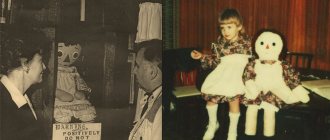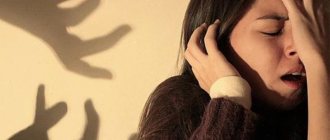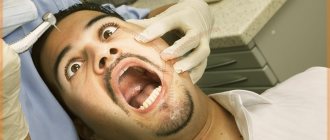Fear, a feeling of discomfort and the desire to run away from a person are nothing more than anthropophobia. Fear takes over when you have to speak on stage or answer in class at the blackboard or in front of an audience at the university. Before going out in public, fear causes your heart to beat loudly, your hands to sweat and tremble, and your legs to become weak. Many people feel a lump in their throat when they are forced to be in a group of other people. Fear of people is one of the forms of social phobia related to neuroses, in the International Directory of Classification of Diseases, listed under the code F 40 - phobic anxiety disorders. American psychiatrist G. Sullivan believed that in order to understand the reason that caused the phobia, it is important to “unravel the tangle” of relationships between a person suffering from fears and other people from his close circle.
What is this disease of fear of people called? Anthropophobia - now you know.
Anthropophobia and social phobia: what are the differences?
Both of these anxiety disorders fall under the same general category: social phobia. Both of them are associated with fear of people, communication with them, or any social activity.
However, there are differences between a fear of people and social phobia. With social phobia, life is much easier for an individual than for an anthropophobe. Experiencing fear of people, the anthropophobe is forced to constantly avoid contact with representatives of any social groups or with all people in general. A sociophobe experiences discomfort when participating in any social activities, when communicating with a team or an unfamiliar company. In his case, eliminating the object of phobia from life is somewhat easier.
Names for fear of people
Not all phobias can be explained; some of them are completely illogical. If the fear of water or heights is due to danger to life, it is not always possible to accurately substantiate the fear of people. What are phobias called?
- Social phobia is the fear of society. A person feels discomfort in a team, when interacting with large groups of people;
- Demophobia – fear of crowds. Fear grips in crowded places, these are: shops, theaters, public transport;
- Anthropophobia is the general concept of fear of people. An individual is uncomfortable not only in a team, but also in the company of one person.
Causes and risk factors of anthropophobia
Although there are several assumptions about what anthropophobia is and what the mechanism of its development is, the exact causes are unknown. Most practicing psychologists are inclined to believe that its development is caused by events that take place in childhood or adolescence.
Anthropophobia is a deviation that occurs due to previously suffered:
- ridicule of peers,
- unfavorable family situation,
- resentment towards parents
- regular intimidation or punishment.
Detailed factors increase the likelihood that a child (whose personality is just beginning to form) loses trust in others. If you notice that he prefers privacy, this signal is worth paying attention to. A child, feeling calmer and more confident when alone, may come to the conclusion that the only safe person for him is himself. This is the starting point that leads to the emergence of anthropophobia.
Fear of people most often overtakes individuals:
- with a weak type of nervous system,
- prone to increased levels of anxiety,
- with neuroses,
- having low self-esteem and excessive self-criticism.
People with anthropophobia do not consider themselves part of society, sometimes as inferior or useless members of it. This is an exaggerated reaction of the psyche to a possible repetition of violence, ridicule and aggression from others, which came from parents, classmates or strangers.
How to behave in society
When an individual withdraws into himself, he loses communication skills. Every exit into a public place turns into a test, but without communication there is no full life. While in society, you need to:
- Don't be afraid to speak and express your opinion. Often a person is afraid not of conversation, but of resistance and a negative reaction. It is necessary to realize that if they do not agree with the expressed opinion, nothing terrible will happen;
- Come to meetings. You should not refuse invitations to events or walks. Having received an invitation, a person must realize that he is welcome, otherwise they would not invite him;
- Do not avoid communication, answer phone calls. You won’t be able to immediately avoid anxiety during a conversation, but you don’t need to remain silent either. You need to speak calmly and measuredly, not forgetting to inhale and exhale in time.
Note! After spending a long time without communication, speaking skills are lost and diction deteriorates. People are not only afraid, but also cannot structure their speech correctly. To feel confident and ready to answer a question, you need to do exercises to develop diction and read books. A good speech always adds confidence.
Signs of anthropophobia
Anthropophobia is expressed by a specific clinical picture, which involves cognitive and autonomic disorders. Cognitive manifestations include an inexplicable, persistent fear of the thought of speaking, touching a person, going out to people, or meeting a dangerous person. Autonomic symptoms of fear make themselves felt:
- tremor of the limbs;
- attack of suffocation;
- rapid heartbeat;
- numbness;
- redness or pallor of the face, spots on the chest;
- sudden sweating;
- vomiting, diarrhea.
When panic attacks occur in anthropophobes, there is a need for compulsions - obsessive motor acts that have a protective meaning and are of the same type. Often compulsions are associated with cleaning (washing hands, cleaning, wiping surfaces, dishes). Fear of people, as a rule, has a high level of comorbidity, that is, it is combined with other disorders or diseases, such as depression, alcoholism, and drug addiction. Fear of communication is associated with autism.
Social phobia
The main difference between social phobia is the presence of intense, periodic fear of a person’s presence in society. The diagnosis of social phobia is given to people who express an excessive fear of performing actions, after which they may be overcome by a feeling of embarrassment or anxiety, since all this will be observed by other people and they will be judged for something. For example, the skin on the face or body turned red, there was excessive sweat, speech was hesitating, hands were shaking, etc.). This fear is associated with corresponding behavior that leads to severe emotional stress, which can have a negative impact on daily work and relationships.
Below is a list of psycho-emotional and physiological symptoms observed in patients with this diagnosis:
- A person is afraid that other people, especially strangers, will judge him.
- Expression of excessive anxiety when faced with various situations every day.
- A feeling of intense fear or anxiety before a significant social situation.
- A feeling of fear that others may regard actions as compromising or degrading a person.
- A person is afraid that other people will notice his nervousness.
- The heartbeat and breathing accelerate and shortness of breath occurs.
- Limbs and body tremble.
- The voice is shaking.
- Nausea or upset stomach.
- Increased sweating.
- Feeling dizzy.
Features
Fear of people is a form of social phobia. Its peculiarity lies in the fact that in the life of an individual subject to it there is always an object of fear, which is almost impossible to remove or isolate.
Often, a phobia spreads to a specific group of people who have common external or behavioral characteristics:
- fat or thin;
- bald;
- bearded;
- with tattoos;
- sociable or silent;
- any other.
An anthropophobe may be afraid of accidental touching. He avoids looking other people in the eye and tries to look away. Forced communication causes tangible physical discomfort to a person suffering from a fear of people. Information belongs to rewmed website
Symptoms and manifestations of fear
Symptoms range from discomfort to panic attacks when seeing people. Manifestations:
- fear of all strangers, in advanced cases, spreads to loved ones;
- attempts to avoid communication with certain groups of individuals: cheerful, serious, drunk;
- compulsivity – when in a stressful situation, a person suppresses emotions with obsessive actions: biting his nails, counting passers-by, jerking his leg;
- desire to be in a personal comfort zone;
- new acquaintances, looks and touches cause discomfort;
- obsessive thoughts of being stalked;
- deliberate refusal to help others;
- attempts to find a catch - positive reviews are perceived as ridicule, mockery;
- deterioration of mood and well-being outside the comfort zone.
Mood swings in women and men - what is it called, why does it happen
Fear of people dulls cognitive properties. A person who is very afraid of society cannot concentrate, understand and absorb information. It is difficult for a person to learn, problems may arise during employment and in the workplace, and as a result, a poor financial situation.
Note! Constantly being in fear can provoke overeating. A person calms himself with a portion of fast food or dessert. As a result, excess weight and complexes appear that aggravate anthropophobia.
Stages of anthropophobia
- Easy. The patient at this stage can independently overcome his fear by encountering the person who is the object of his fear. Only a little effort is needed.
- Progressive. Feelings of fear and other negative emotions in a traumatic situation are uncontrollable. For example, a person suffering from a fear of clowns, when faced with a representative of this profession, may experience a feeling of aggression or, on the contrary, tearfulness, his pulse will increase, sweating will increase, and trembling will occur in the limbs or throughout the body.
- Launched. An anthropophobe does not communicate with anyone, even with relatives this happens extremely rarely. Treatment of anthropophobia in this case is only possible by force.
Diagnosis of the disease
Diagnosis of anthropophobia is based on the characteristic signs of the condition and is carried out only by a specialist. It must be remembered that the symptoms of anthropophobia may indicate the presence of certain mental illnesses, so a patient with such a pathology needs an in-depth psychiatric examination. Anthropophobia is often observed together with some other types of phobias, for example, scoptophobia (panic fear of disgrace in front of others) and low self-esteem.
Video
Coffee capsule Nescafe Dolce Gusto Cappuccino, 3 packs of 16 capsules
1305 ₽ More details
Coffee capsules Nescafe Dolce Gusto Cappuccino, 8 servings (16 capsules)
435 ₽ More details
TVs
Treatment of anthropophobia
Anthropophobia requires targeted and long-term therapeutic work. It is very difficult for a person to cope with such a disorder, so the best way out is to consult a specialist. The psychotherapist teaches the patient methods of relieving nervous tension and tells how he can manage his emotions. In the process of group psychotherapy, various life situations are worked through. During such meetings, a person learns to openly express his thoughts and improves communication skills. As a result of psychotherapeutic treatment, the patient becomes ready for contacts in society and gets rid of the destructive defensive model - avoidance behavior.
The fight against anthropophobia begins with a detailed analysis of the causes of its occurrence. The main factor contributing to cure is the patient’s personal interest. If the therapist and the client join forces, relief is possible. During therapy, the patient gradually learns to contact people, starting with the simplest social actions - buying groceries, going to a help desk, traveling on a tram.
Drug treatment consists of prescribing a group of drugs to the patient:
- sedatives (Validol, Novo-passit);
- antidepressants (Hypericin, a drug based on St. John's wort);
- tranquilizers (Afobazol, Phenazepam).
There are contraindications, consultation with a specialist is necessary!
Traditional methods of treatment
A phobia cannot be eliminated with the help of medications, but folk remedies can overcome unpleasant symptoms, cope with increased anxiety, have a calming effect, and improve sleep.
Anthropophobia can be treated with neuroleptics and antipsychotics, these are the rules of the traditional method. They can cause side effects on almost all systems and organs. Traditional treatment has a much gentler effect on the nervous system; the body does not get used to such remedies. In particular, you can drink juice from beets and carrots, infuse mint and lemon balm, juice from fresh motherwort herbs, decoctions from hawthorn berries and aster chamomile.
Demophobia
There are situations when an adult is treated cruelly by a crowd or just individuals, and as a result of the experience he is overcome by demophobia. It can also appear as a concomitant factor in various mental diseases and nervous disorders.
All the people who travel with us in vehicles, meet on the streets, and are in the premises have invisible contact with us. After looking at them, we may have an emotional reaction, or the touch of people will be accompanied by a feeling of discomfort, etc. A set of these impressions can have a direct impact on the feeling of personal space.
Having a panicky fear of large crowds of people, as well as any other phobia, is nothing more than a defensive reaction. With its help, a person not only protects himself, but also access to his borders. And overly sensitive people save personal space by avoiding large crowds, opting for a small group of those with whom they feel comfortable.
Psychotherapy for anthropophobia
Successful treatment of the disorder is only possible if medication is taken in parallel with psychological correction and psychotherapy. Psychotherapy for anthropophobia involves several methods depending on the patient’s personal characteristics.
- Psychoanalysis. This is a rather lengthy process, as a result of which you can find the origins of anthropophobia and get rid of the problem forever.
- Cognitive and behavioral therapy is most effective if the person with anthropophobia knows what caused the disorder, and it happened in adulthood.
- Group psychotherapy is also successfully used in this case and can be combined with individual therapy.
A combination of medication and psychotherapy can be quite effective in treating anthropophobia if a person recognizes the irrationality of their fears and wants to get rid of them. Information belongs to rewmed website
Related posts:
- Panic disorder with agoraphobia The onset of a panic attack is often associated with the fear of getting into...
- Constant fear and anxiety in women Almost all people have experienced feelings of anxiety and fear at least once...
- Can temperature change due to stress? The human body reacts to stress in a variety of ways. Many people are interested in maybe...
- Is mental disorder treatable? By mental disorder, experts usually understand a special mental state that interferes with...
Causes
Fear of people is a phobia, but like other problems of a psychological nature, it arises at an early age, namely in adolescence, when the psyche is most unstable and unformed, regardless of gender.
Among the main reasons are:
- low self-esteem and individual failures;
- fear of criticism and the risk of embarrassment;
- chronic psychotraumatic effects (for example, overly strict upbringing);
- physical, sexual or mental violence.
However, there are cases where fear of people also occurred in adults after experiencing an extreme traumatic event.










